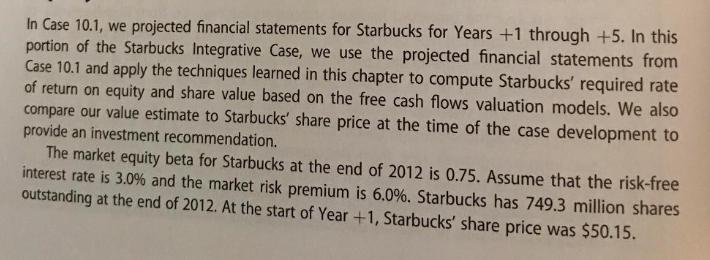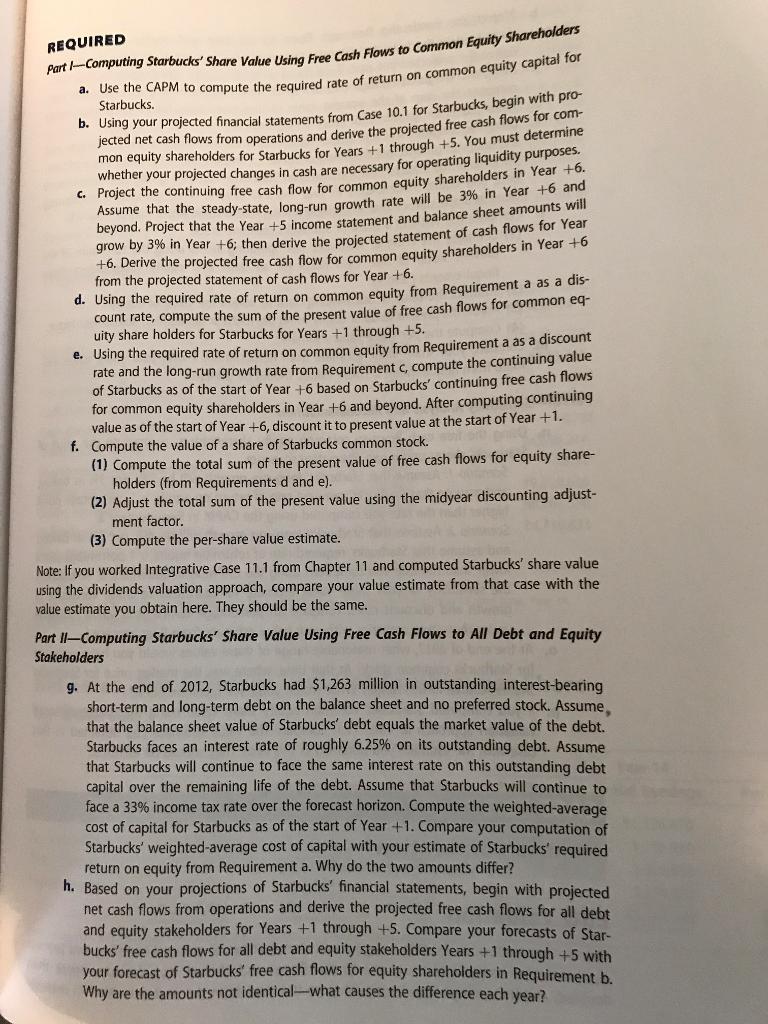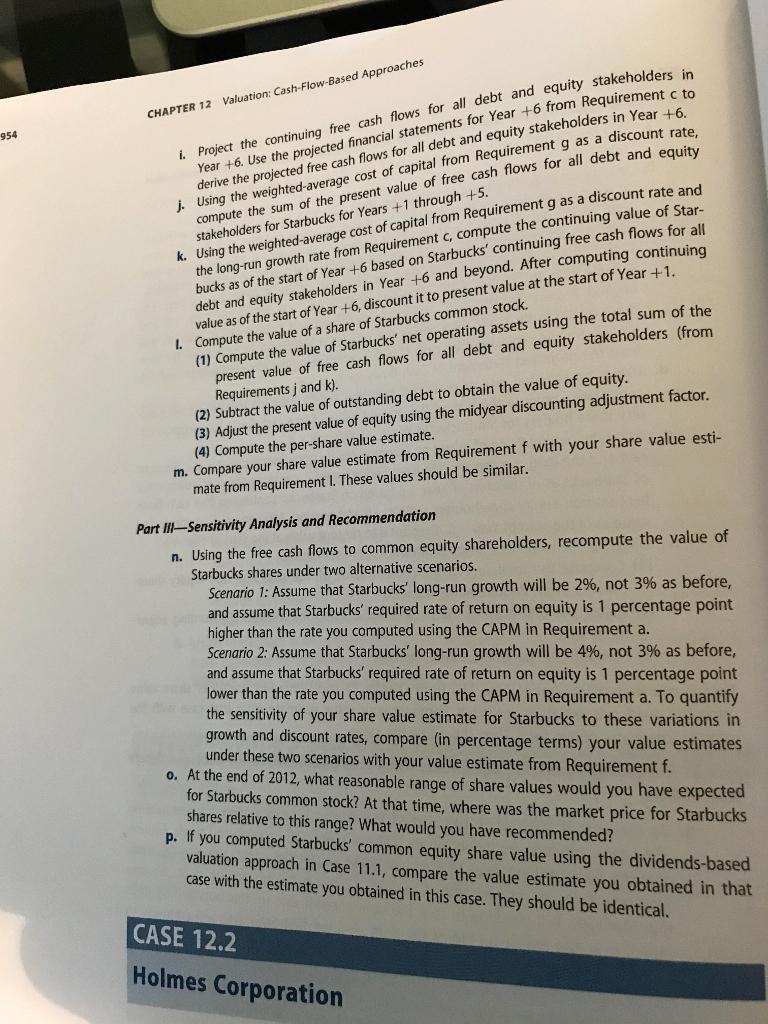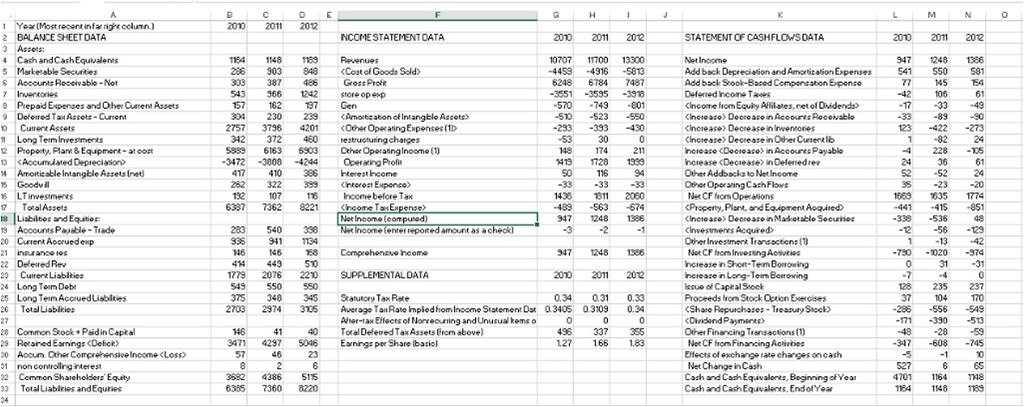Answered step by step
Verified Expert Solution
Question
1 Approved Answer
In Case 10.1, we projected financial statements for Starbucks for Years +1 through +5. In this portion of the Starbucks Integrative Case, we use




In Case 10.1, we projected financial statements for Starbucks for Years +1 through +5. In this portion of the Starbucks Integrative Case, we use the projected financial statements from Case 10.1 and apply the techniques learned in this chapter to compute Starbucks' required rate of return on equity and share value based on the free cash flows valuation models. We also compare our value estimate to Starbucks' share price at the time of the case development to provide an investment recommendation. The market equity beta for Starbucks at the end of 2012 is 0.75. Assume that the risk-free interest rate is 3.0% and the market risk premium is 6.0%. Starbucks has 749.3 million shares outstanding at the end of 2012. At the start of Year +1, Starbucks' share price was $50.15. REQUIRED Part I-Computing Starbucks' Share Value Using Free Cash Flows to Common Equity Shareholders a. Use the CAPM to compute the required rate of return on common equity capital for Starbucks. b. Using your projected financial statements from Case 10.1 for Starbucks, begin with pro- jected net cash flows from operations and derive the projected free cash flows for com- mon equity shareholders for Starbucks for Years +1 through +5. You must determine whether your projected changes in cash are necessary for operating liquidity purposes. c. Project the continuing free cash flow for common equity shareholders in Year +6. Assume that the steady-state, long-run growth rate will be 3% in Year +6 and beyond. Project that the Year +5 income statement and balance sheet amounts will grow by 3% in Year +6; then derive the projected statement of cash flows for Year +6. Derive the projected free cash flow for common equity shareholders in Year +6 from the projected statement of cash flows for Year + 6. d. Using the required rate of return on common equity from Requirement a as a dis- count rate, compute the sum of the present value of free cash flows for common eq- uity share holders for Starbucks for Years +1 through +5. e. Using the required rate of return on common equity from Requirement a as a discount rate and the long-run growth rate from Requirement c, compute the continuing value of Starbucks as of the start of Year +6 based on Starbucks' continuing free cash flows for common equity shareholders in Year +6 and beyond. After computing continuing value as of the start of Year +6, discount it to present value at the start of Year +1. f. Compute the value of a share of Starbucks common stock. (1) Compute the total sum of the present value of free cash flows for equity share- holders (from Requirements d and e). (2) Adjust the total sum of the present value using the midyear discounting adjust- ment factor. (3) Compute the per-share value estimate. Note: If you worked Integrative Case 11.1 from Chapter 11 and computed Starbucks' share value using the dividends valuation approach, compare your value estimate from that case with the value estimate you obtain here. They should be the same. Part II-Computing Starbucks' Share Value Using Free Cash Flows to All Debt and Equity Stakeholders g. At the end of 2012, Starbucks had $1,263 million in outstanding interest-bearing short-term and long-term debt on the balance sheet and no preferred stock. Assume, that the balance sheet value of Starbucks' debt equals the market value of the debt. Starbucks faces an interest rate of roughly 6.25% on its outstanding debt. Assume that Starbucks will continue to face the same interest rate on this outstanding debt capital over the remaining life of the debt. Assume that Starbucks will continue to face a 33% income tax rate over the forecast horizon. Compute the weighted-average cost of capital for Starbucks as of the start of Year +1. Compare your computation of Starbucks' weighted-average cost of capital with your estimate of Starbucks' required return on equity from Requirement a. Why do the two amounts differ? h. Based on your projections of Starbucks' financial statements, begin with projected net cash flows from operations and derive the projected free cash flows for all debt and equity stakeholders for Years +1 through +5. Compare your forecasts of Star- bucks' free cash flows for all debt and equity stakeholders Years +1 through +5 with your forecast of Starbucks' free cash flows for equity shareholders in Requirement b. Why are the amounts not identical-what causes the difference each year? 954 CHAPTER 12 Valuation: Cash-Flow-Based Approaches i. Project the continuing free cash flows for all debt and equity stakeholders in Year +6. Use the projected financial statements for Year +6 from Requirement c to derive the projected free cash flows for all debt and equity stakeholders in Year +6. j. Using the weighted average cost of capital from Requirement g as a discount rate, compute the sum of the present value of free cash flows for all debt and equity stakeholders for Starbucks for Years +1 through +5. k. Using the weighted-average cost of capital from Requirement g as a discount rate and the long-run growth rate from Requirement c, compute the continuing value of Star- bucks as of the start of Year +6 based on Starbucks' continuing free cash flows for all debt and equity stakeholders in Year +6 and beyond. After computing continuing value as of the start of Year +6, discount it to present value at the start of Year +1. I. Compute the value of a share of Starbucks common stock. (1) Compute the value of Starbucks' net operating assets using the total sum of the present value of free cash flows for all debt and equity stakeholders (from Requirements j and k). (2) Subtract the value of outstanding debt to obtain the value of equity. (3) Adjust the present value of equity using the midyear discounting adjustment factor. (4) Compute the per-share value estimate. m. Compare your share value estimate from Requirement f with your share value esti- mate from Requirement I. These values should be similar. Part III-Sensitivity Analysis and Recommendation n. Using the free cash flows to common equity shareholders, recompute the value of Starbucks shares under two alternative scenarios. Scenario 1: Assume that Starbucks' long-run growth will be 2%, not 3% as before, and assume that Starbucks' required rate of return on equity is 1 percentage point higher than the rate you computed using the CAPM in Requirement a. Scenario 2: Assume that Starbucks' long-run growth will be 4%, not 3% as before, and assume that Starbucks' required rate of return on equity is 1 percentage point lower than the rate you computed using the CAPM in Requirement a. To quantify the sensitivity of your share value estimate for Starbucks to these variations in growth and discount rates, compare (in percentage terms) your value estimates under these two scenarios with your value estimate from Requirement f. o. At the end of 2012, what reasonable range of share values would you have expected for Starbucks common stock? At that time, where was the market price for Starbucks shares relative to this range? What would you have recommended? p. If you computed Starbucks' common equity share value using the dividends-based valuation approach in Case 11.1, compare the value estimate you obtained in that case with the estimate you obtained in this case. They should be identical. CASE 12.2 Holmes Corporation A 1 Year (Most recent infar right column) 2 BALANCE SHEET DATA 3 Assets: 4 Cach and Cash Equivalents 5 Marketable Securities & Accounts Receivable-Not 7 Inventories 8 Prepaid Expenses and Other Current Assets 9 Deferred Tax Assets-Current 10 Current Assets 11 Long Term Investments 12 Property, Plant & Equipment-at cost 13
Step by Step Solution
★★★★★
3.43 Rating (162 Votes )
There are 3 Steps involved in it
Step: 1

Get Instant Access to Expert-Tailored Solutions
See step-by-step solutions with expert insights and AI powered tools for academic success
Step: 2

Step: 3

Ace Your Homework with AI
Get the answers you need in no time with our AI-driven, step-by-step assistance
Get Started


